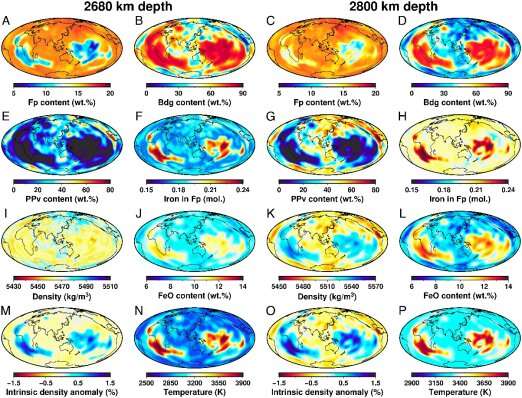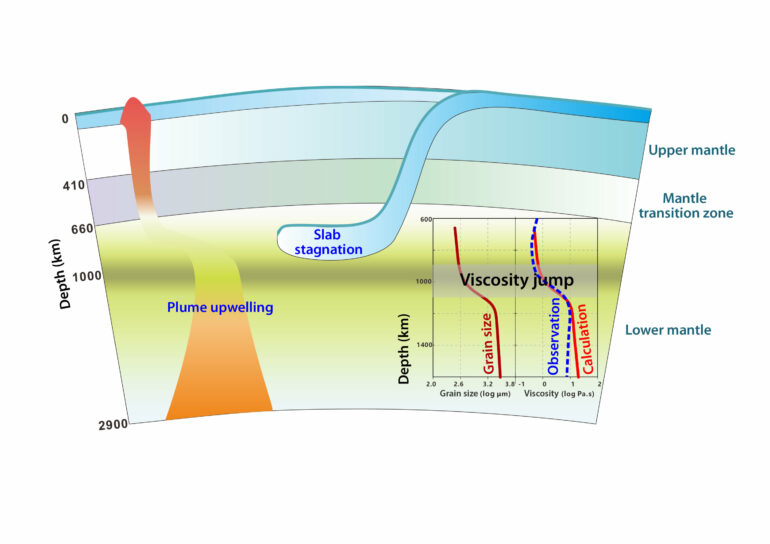A research team led by Professor Wu Zhongqing from the School of Earth and Space Sciences at the University of Science and Technology of China of the Chinese Academy of Sciences has made a significant breakthrough in constraining the material composition and thermal state of the Earth’s lower mantle.
Their research findings, titled “Compositional and thermal state of the lower mantle from joint 3D inversion with seismic tomography and mineral elasticity,” were published in the journal Proceedings of the National Academy of Sciences.
The Earth’s interior can be roughly divided into the crust, upper mantle, lower mantle, and core. The lower mantle, located at depths ranging from 660 to 2,890 km below the surface, comprises a substantial portion of the Earth’s volume and mass. It plays a critical role in the planet’s structure and dynamics.
Previous seismological studies have revealed variations in seismic wave velocities within the lower mantle, including large-scale low shear wave velocity provinces (LLSVPs) beneath Africa and the Pacific. However, the nature, origin, and implications of these anomalies remain incompletely understood. Therefore, obtaining a comprehensive understanding of the spatial distribution of material composition and temperature within the lower mantle is crucial for unraveling the Earth’s formation, evolution, and dynamics.
To address these challenges, the research team employed a combination of seismic tomography and the elastic properties of minerals to determine the composition and spatial distribution of mantle materials and temperatures. However, experimental measurements of mineral elasticity under the extreme conditions of the lower mantle present significant difficulties.
To overcome this, Professor Zhongqing’s team developed a novel first-principles calculation method that is computationally efficient, representing less than one-tenth of the conventional methods. Utilizing this approach, the team extensively studied the elastic properties of key minerals in the lower mantle and achieved results consistent with experimental data obtained under relatively lower temperatures and pressures.

In-depth Analysis of Lateral Composition and Temperature Distribution at Depths of 2680km and 2800km. © University of Science and Technology of China
By integrating computed high-temperature and high-pressure elastic data of lower mantle minerals with a three-dimensional tomographic imaging model, the research team successfully inverted the three-dimensional mineral composition and temperature distribution of the entire lower mantle using the Markov chain Monte Carlo method. Furthermore, they derived a three-dimensional density model of the lower mantle.
The inversion results revealed that the lateral temperature distribution in the lower mantle follows a Gaussian pattern, with minimal variations within a depth range of 1,600 kilometers. However, as the depth increases, the distribution gradually widens. Notably, at the very bottom of the lower mantle, the lateral temperature distribution deviates from the Gaussian pattern, indicating strong lateral heterogeneity, likely associated with the presence of LLSVPs.
Further analysis demonstrated that thermal anomalies primarily contribute to velocity anomalies in the upper portion of the lower mantle, while variations in chemical composition predominantly influence velocity anomalies in the deepest part of the mantle.
The study also disclosed that LLSVPs exhibit higher densities at the bottom of the lower mantle compared to the surrounding mantle, while displaying lower densities above a depth of approximately 2,700 kilometers. Moreover, LLSVPs are characterized by elevated temperatures and enriched concentrations of iron and bridgmanite, supporting the hypothesis that LLSVPs may have originated from primordial basal magma oceans during the early stages of Earth’s development.
The findings of this research provide essential insights into the composition and thermal state of the Earth’s lower mantle, significantly advancing our understanding of the planet’s deep structure. These insights are expected to have a profound impact on research pertaining to the formation, evolution, and dynamics of Earth.
More information:
Xin Deng et al, Compositional and thermal state of the lower mantle from joint 3D inversion with seismic tomography and mineral elasticity, Proceedings of the National Academy of Sciences (2023). DOI: 10.1073/pnas.2220178120
Provided by
University of Science and Technology of China
Citation:
Seismological study provides insight into composition and thermal state of Earth’s lower mantle (2023, July 14)



